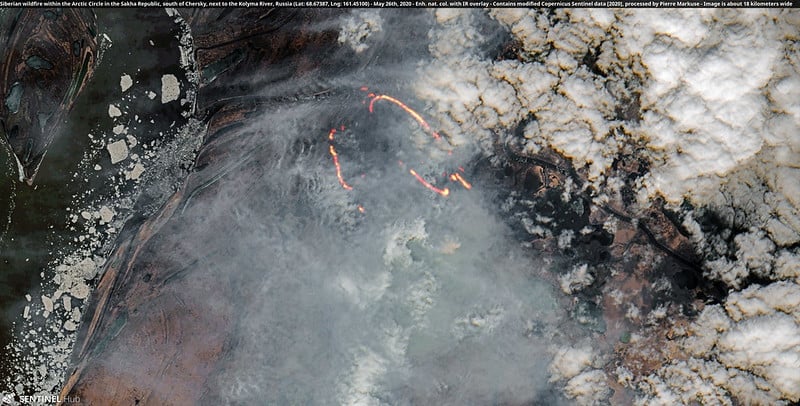Buried beneath the snow line,
these smouldering corpses
begin to glow.
Forgotten fires,
whose reanimated embers
burn brightly
across the tundra;
frozen bodies recoiling
at the heat
of their undying embrace.
Thawed to life by
distant warming
these undead hordes now
straddle horizons;
crimson fingers
flickering over
blue-veined memories,
as they dance
impossibly beyond
the water’s edge.
Nervously
we shift our gaze
towards a restless earth,
as unwanted resurrections
blaze across the landscape.

This poem is inspired by new research, which has found that the ways in which Arctic wildfires burn are potentially changing, with strong consequences for the global climate.
The 2020 Arctic wildfire season began two months early and was unprecedented in scope; in addition to the increase in severity and occurrence, two new features for the way in which these fires burn have also being identified. The first is what is known as holdover, or zombie, fires. These fires occur when fire from a previous growing season smoulders in carbon-rich peat underground over the winter, re-igniting on the surface several months (or even years) later, when the weather begins to warm. The second feature that has been observed is the occurrence of fire in what were previously thought to be fire-resistant landscapes. As the Arctic tundra becomes hotter and drier due to global warming, vegetation types such as sedges, grass, and moss, that are not typically thought of as fuels, start to catch fire. Even wet landscapes like bogs, fens, and marshes are also becoming vulnerable to burning in the changing climate.
More than half of the fires detected in Siberia this year were north of the Arctic Circle, occurring on permafrost that has a high percentage of ground ice. This type of permafrost contains enormous amounts of carbon, and global climate models currently do not account for their rapid thawing and subsequent release of greenhouse gases. At the local level, the rapid thawing of this permafrost would result in subsidence, floods, and landslides. Understanding these new fire regimes is therefore essential in order to better understand the impact that they will have on both the local and global level. However, while satellite imagery could potentially help to map the extent and timing of these new surface fires, measurements made on the ground are still needed to help calibrate any observations that are made by satellites. As such, addressing the gaps in our current understanding will require critical input from Indigenous and local communities, as well as collaboration across many different scientific disciplines.
Discover more from The Poetry of Science
Subscribe to get the latest posts sent to your email.
this is a very beautiful poem on a depressing phenomenon.
Have a good weekend Sam,
Rolf
Thanks Rolf,
I found the research to be very upsetting, as it seems that we are clearly beyond several tipping points in the global climate system. I just hope that this proves to be a wakeup call…
I am a Poet as well~ Thank you for scribing so beautifully and using poetry as a portal for knowledge and understanding on the current fragile state of our planet and it’s environment. I love science, but I also feel that to heal the earth…we must first heal humanity and work together for the sake of all. If I may share my poem~
Peaceful Knowledge
This world was given to everyone to share the best we can
To live together on one land working hand in hand
The land is not to battle for or to take for our own
But for each of us to have a space
A place to call our home
We don’t know the outcome of what the future holds
But little bits of something new can take away the old
If each of us talked with someone within our reach
And learned about their lives, their culture’s and beliefs
Then there might be less fighting
And knowledge might bring us peace ~
Penny K Lamkins
Hope you have a great day!
Thank you Penny for your kind words, and also for sharing this brilliant poem! 😀
Sam